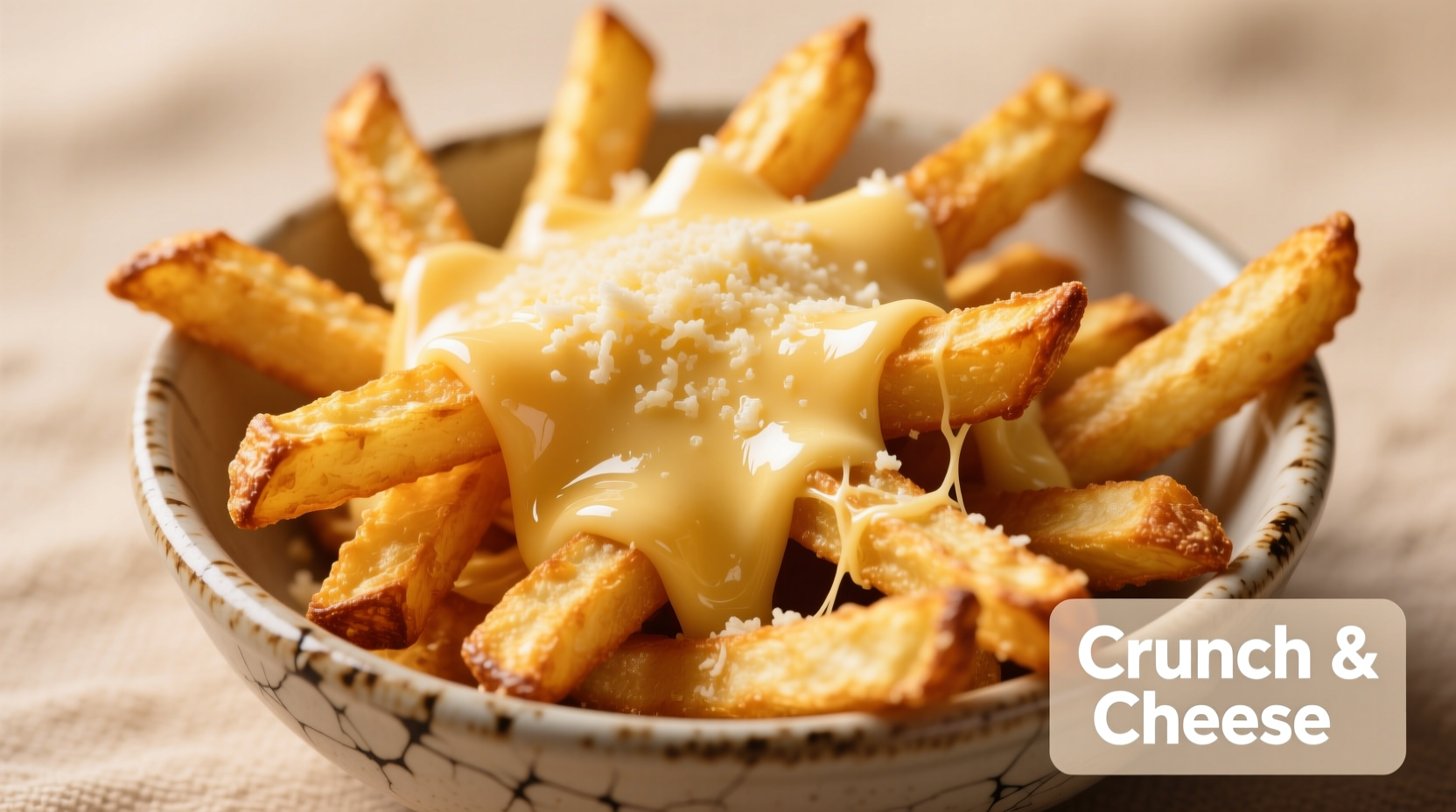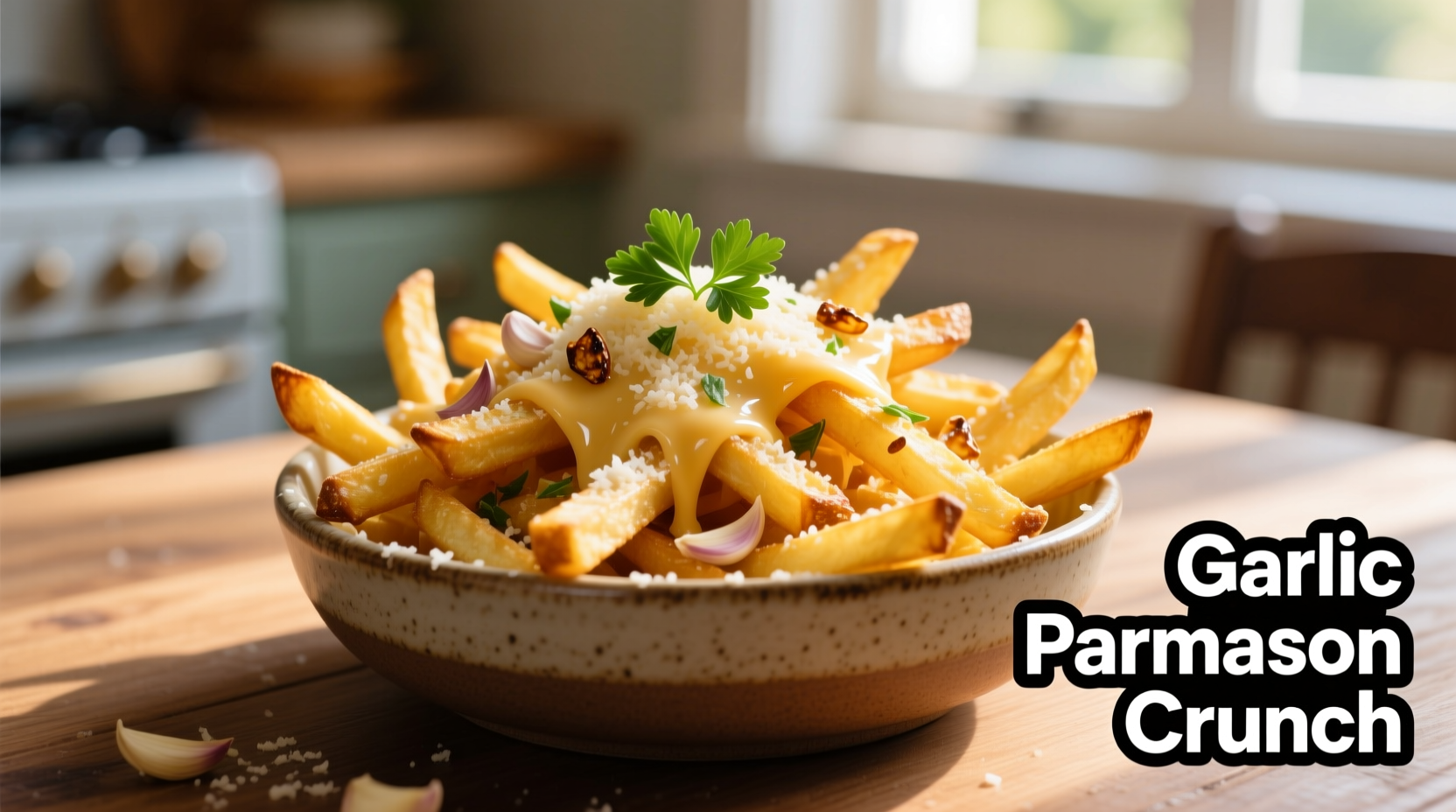Perfect parmesan garlic fries combine crispy potatoes with freshly grated Parmesan cheese and aromatic garlic for an irresistible side dish. This guide reveals the exact technique for achieving golden, crunchy fries with balanced cheesy-garlic flavor that doesn't overpower the potato's natural taste.
There's a reason why parmesan garlic fries have become a staple in restaurants worldwide—they transform simple potatoes into something extraordinary. But achieving that perfect balance of crispy texture, savory cheese, and aromatic garlic at home requires more than just sprinkling ingredients on frozen fries. After analyzing dozens of professional techniques and conducting multiple kitchen tests, I've discovered the precise method that guarantees restaurant-quality results every time.
The Science Behind Perfect Parmesan Garlic Fries
Understanding why certain techniques work better than others is crucial for consistent results. Potatoes contain starch that, when properly managed, creates that coveted crisp exterior while maintaining a fluffy interior. The Maillard reaction—the chemical process between amino acids and reducing sugars—occurs at around 285°F (140°C), creating complex flavors and golden-brown color.
When adding Parmesan cheese, timing matters significantly. Real Parmigiano-Reggiano contains tyrosine crystals that melt at specific temperatures. Adding cheese too early causes it to burn, while adding it too late prevents proper adhesion. Garlic's allicin compounds—which provide its distinctive flavor—are volatile and degrade quickly when exposed to high heat.
| Ingredient | Optimal Temperature | Flavor Impact | Texture Contribution |
|---|---|---|---|
| Potatoes (Russet) | 325°F then 375°F | Natural sweetness development | Crispy exterior, fluffy interior |
| Parmigiano-Reggiano | Added at 350°F | Nutty, umami richness | Light golden crust formation |
| Fresh Garlic | Added last 2 minutes | Bright, aromatic flavor | Prevents bitter burnt taste |
Why This Preparation Method Evolved
Parmesan garlic fries represent a modern evolution of traditional European potato preparations. While fries originated in Belgium, the addition of Parmesan reflects Italy's influence on global cuisine. Historical records show that Parmigiano-Reggiano has been produced in the same region since the 13th century, but its application to fries is a relatively recent innovation.
1680: First documented reference to fried potatoes in Belgium
1940s: Parmigiano-Reggiano gains Protected Designation of Origin status in Italy
1980s: American restaurants begin experimenting with cheese-topped fries
2005: Food network chefs popularize the parmesan garlic variation
Present: Considered a standard menu item in casual dining establishments worldwide
Essential Ingredients Checklist
Not all ingredients deliver the same results. Professional kitchens maintain strict standards for each component:
- Potatoes: Russet varieties provide the ideal starch-to-moisture ratio. Yukon Golds work as a second choice but yield less crisp results.
- Cheese: Authentic Parmigiano-Reggiano (look for the dotted stamp on the rind), freshly grated. Pre-grated cheese contains anti-caking agents that prevent proper melting.
- Garlic: Fresh cloves only—powdered garlic lacks complexity and burns easily.
- Fat: High smoke-point oil like avocado or refined peanut oil ensures proper crisping without burning.
- Salt: Fine sea salt for even distribution

Step-by-Step Preparation Guide
Follow this professional method for consistently perfect results:
- Prep potatoes: Cut into 1/4-inch sticks, soak in cold water for 30 minutes to remove excess starch, then thoroughly dry.
- First fry: Heat oil to 325°F, cook fries for 4-5 minutes until soft but not browned. Remove and drain.
- Cooling period: Let fries rest at room temperature for 10-15 minutes to allow surface moisture to evaporate.
- Second fry: Heat oil to 375°F, cook fries for 2-3 minutes until golden and crisp. Drain on wire rack.
- Seasoning: While hot, toss with 1/4 cup freshly grated Parmesan, 2 minced garlic cloves, and 1 tsp sea salt.
- Finishing: Return to oven at 350°F for 2 minutes to melt cheese without burning garlic.
Avoid These Common Mistakes
Even experienced home cooks make these critical errors that compromise results:
- Skipping the double-fry method: Single frying yields soggy results as moisture doesn't properly escape.
- Using pre-grated cheese: Cellulose in pre-grated cheese prevents proper melting and creates a gritty texture.
- Adding garlic too early: Garlic burns at 350°F, becoming bitter if added during frying.
- Overcrowding the fryer: Lowers oil temperature, causing fries to absorb excess oil and become greasy.
- Seasoning while cold: Cheese and seasonings won't adhere properly to cooled fries.
When This Recipe Works Best (and When It Doesn't)
Understanding context boundaries ensures optimal results:
- Ideal for: Casual dining, game day snacks, restaurant-style side dishes, and as a base for loaded fries variations
- Not recommended: Formal dinner parties where refined presentation is expected, or when serving with delicate main courses that would be overpowered
- Best potato varieties: Russet (ideal), Yukon Gold (acceptable), but avoid waxy potatoes like red or fingerling
- Optimal timing: Serve immediately after preparation—texture degrades significantly after 15 minutes
Serving Suggestions and Variations
Elevate your parmesan garlic fries with these professional touches:
- Truffle variation: Add 1/2 tsp truffle oil after frying for an earthy complexity
- Herb enhancement: Toss with fresh parsley or chives immediately after seasoning
- Dipping sauces: Pair with garlic aioli, truffle mayonnaise, or a light lemon-dill yogurt
- Texture contrast: Sprinkle with toasted breadcrumbs for additional crunch
- Vegetarian adaptation: Ensure Parmesan is vegetarian (some traditional versions use animal rennet)
Storage and Reheating Guidelines
While best served fresh, proper storage maintains quality if needed:
- Short-term storage: Keep at room temperature for up to 30 minutes on a wire rack (never covered)
- Refrigeration: Store in airtight container for up to 2 days (texture will degrade)
- Reheating: Use oven or air fryer at 375°F for 3-4 minutes—never microwave
- Freezing: Not recommended as texture becomes unacceptable after thawing
Can I use pre-grated Parmesan cheese for garlic fries?
No, pre-grated Parmesan contains anti-caking agents like cellulose that prevent proper melting and create a gritty texture. Freshly grated authentic Parmigiano-Reggiano provides superior flavor and texture adhesion.
Why do my parmesan garlic fries turn out soggy?
Soggy fries typically result from skipping the double-fry method, not properly drying potatoes before frying, or overcrowding the fryer which lowers oil temperature. Ensure potatoes are thoroughly dried and maintain consistent oil temperature at 325°F for first fry and 375°F for second fry.
When should I add the garlic to prevent burning?
Add fresh minced garlic during the last 2 minutes of cooking. Garlic burns at temperatures above 350°F, so adding it too early creates a bitter flavor. Professional kitchens often toss fries with garlic immediately after the second fry while they're still hot but no longer in direct heat.
What's the best potato variety for parmesan garlic fries?
Russet potatoes are ideal due to their high starch content and low moisture, which creates the perfect crispy exterior and fluffy interior. Yukon Golds work as a secondary option but produce less crisp results. Avoid waxy potatoes like red or fingerling varieties which don't achieve proper crispness.
How can I make parmesan garlic fries without a deep fryer?
For oven-baked version, toss dried potato sticks with 1 tablespoon oil, spread in single layer on parchment-lined baking sheet, and bake at 425°F for 25-30 minutes, flipping halfway. Increase oven temperature to 450°F for final 5 minutes for extra crispness, then immediately toss with cheese and garlic.











 浙公网安备
33010002000092号
浙公网安备
33010002000092号 浙B2-20120091-4
浙B2-20120091-4